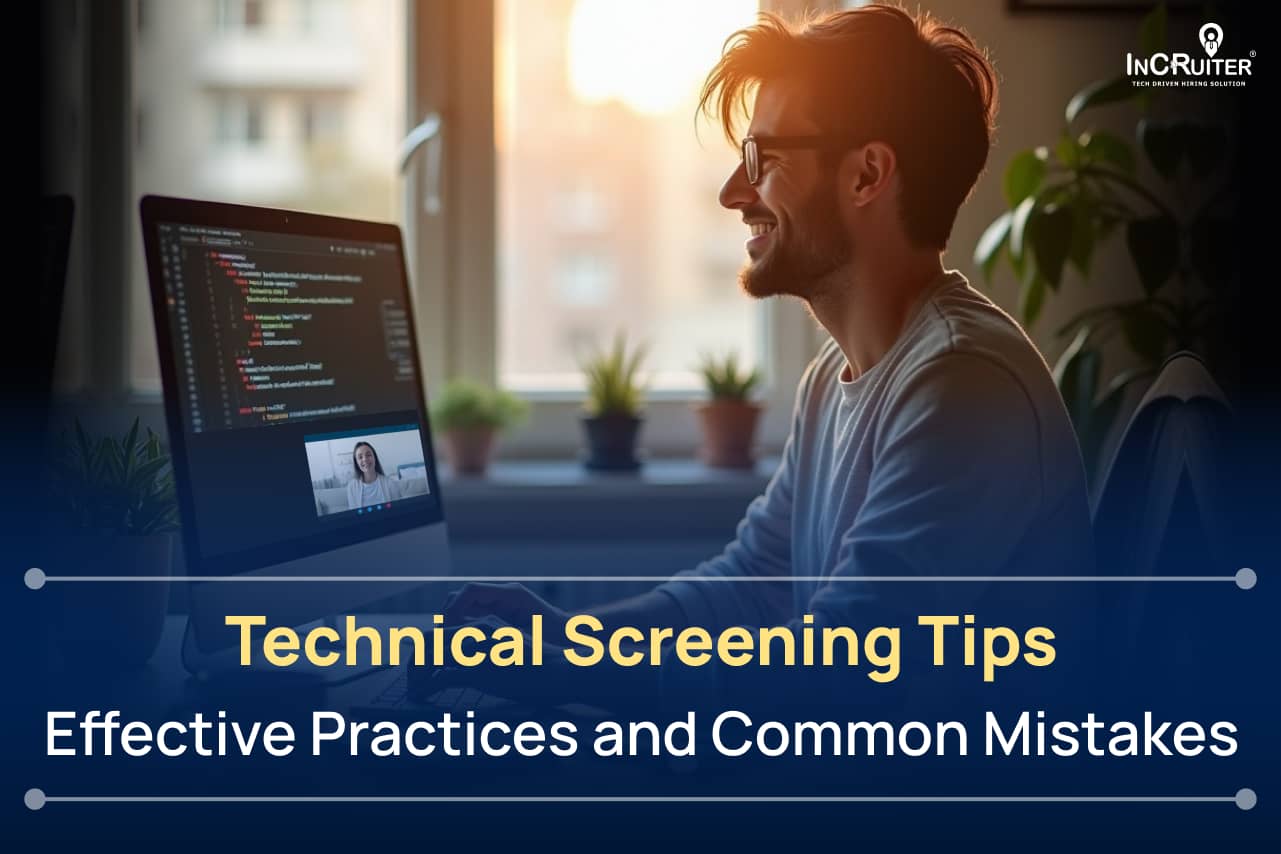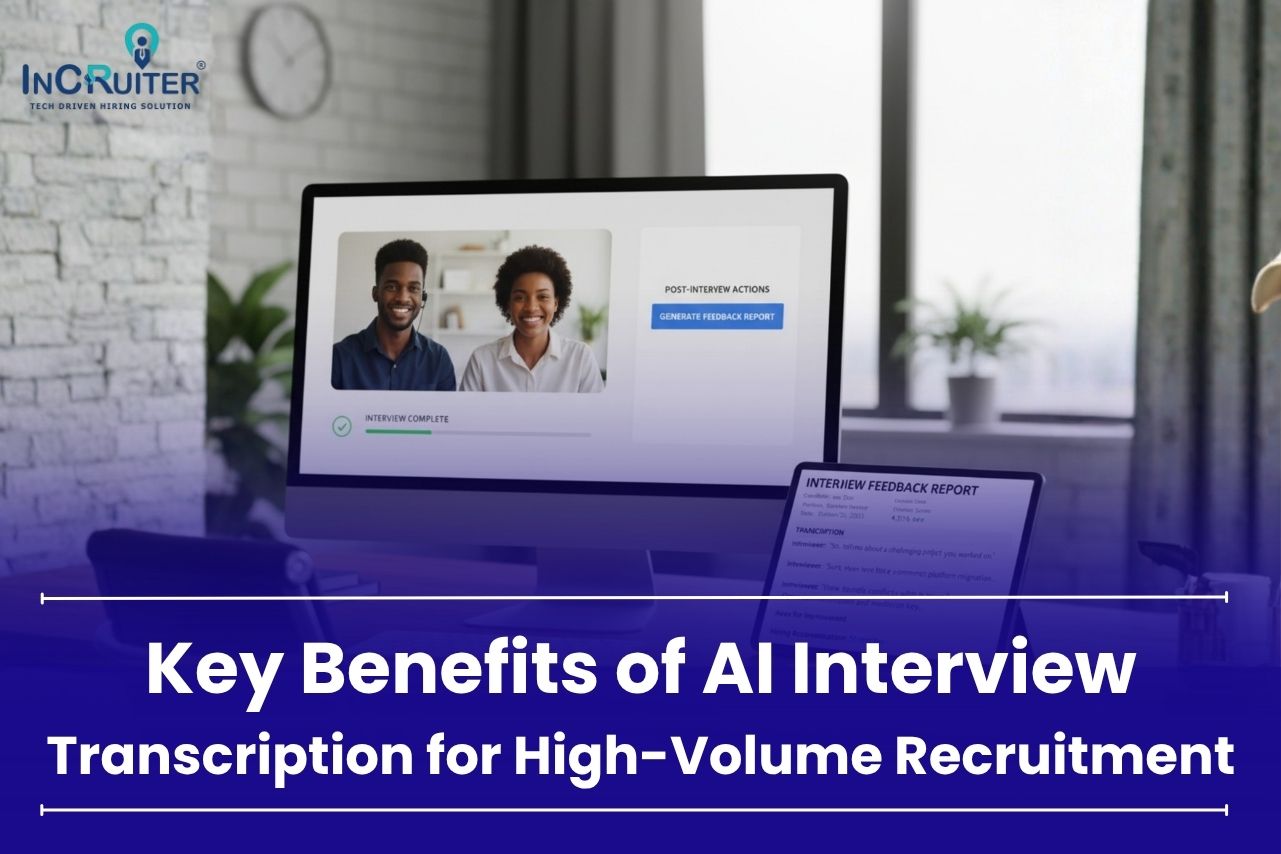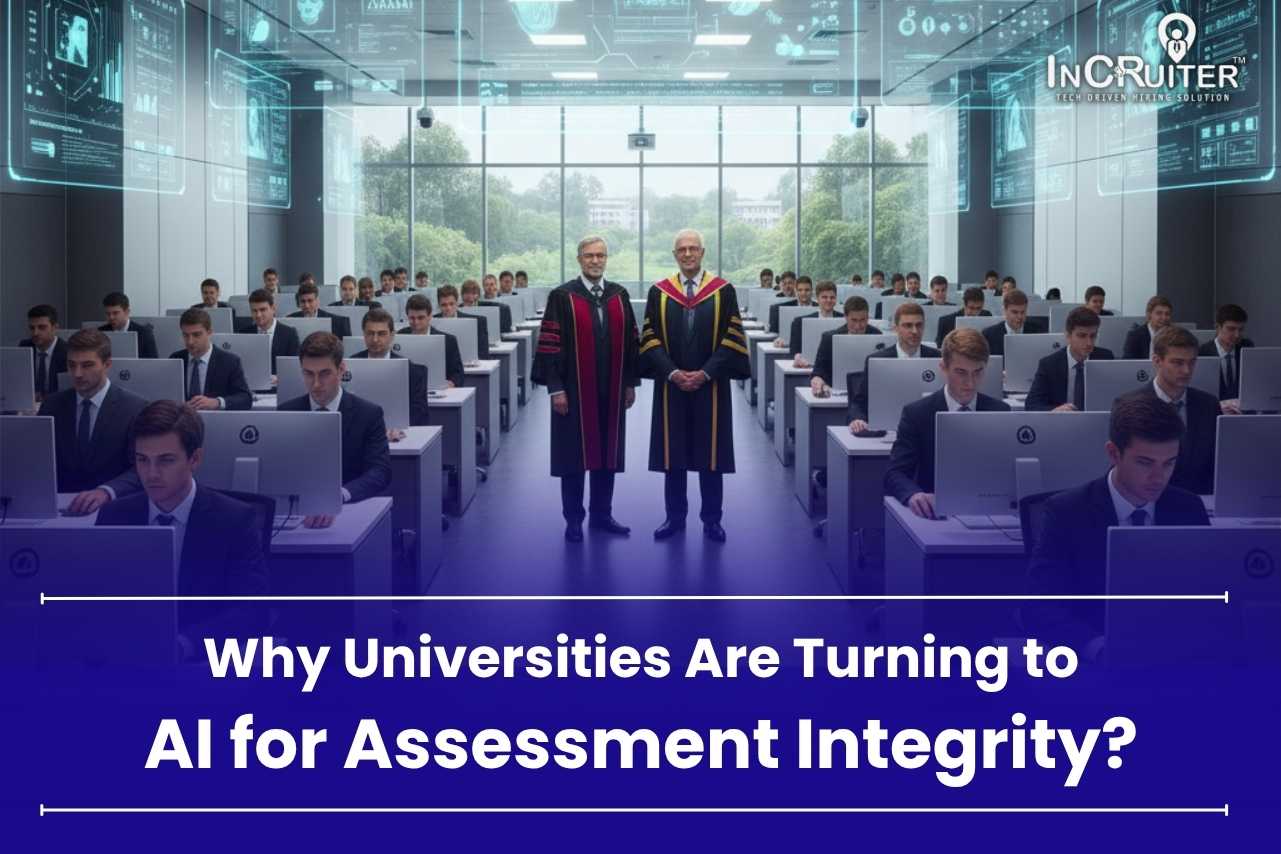Technical hiring isn’t what it used to be. It’s fast-paced, high-stakes, and packed with pressure to find talent that’s not just qualified but truly a perfect fit. Companies today need more than just a good resume to decide who to bring on board. This is where technical screening services come in, offering targeted ways to sift through a pool of candidates efficiently and accurately. Gone are the days of relying solely on traditional interviews; companies now have to adapt to smarter, tech-driven approaches, especially when tackling specific skills in coding, development, or engineering roles.
In this guide, we’ll dive into the best practices for technical screening and call out the common mistakes to avoid. We’ll also explore how tools like AI-powered video interviewing platforms and technical coding challenges streamline the hiring process, bringing you closer to hiring success. Whether you’re an HR professional, a hiring manager, or just curious about the latest in recruitment, these insights will keep you a step ahead. Let’s cut through the noise and get into real, actionable strategies that can change how you hire.
Effective Practices for Technical Screening
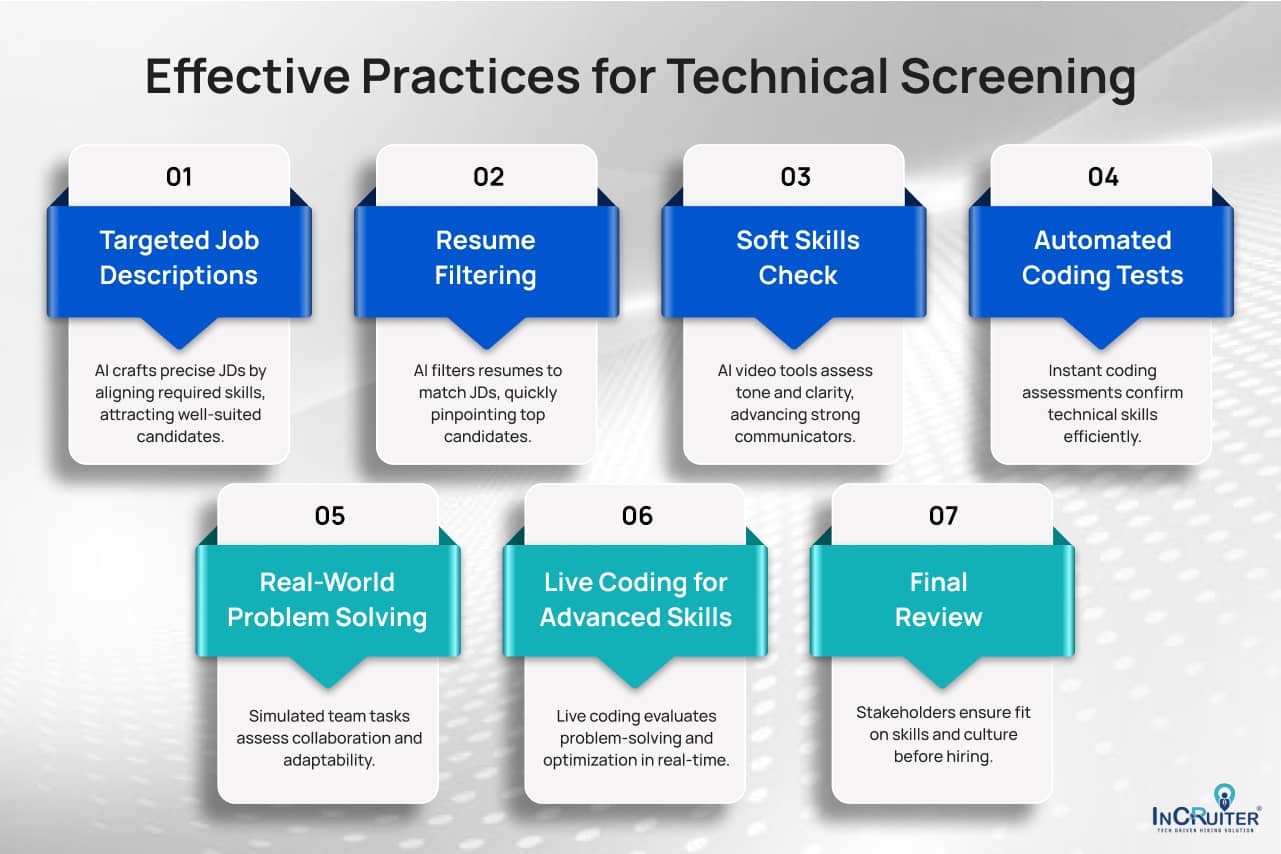
To screen candidates effectively, start with a precise outline of the skills, experience, and tools required for the role. Think beyond general titles like “developer” and dive into specific competencies, whether it’s expertise in programming languages, familiarity with agile frameworks, or experience in particular databases.
Identifying these details not only clarifies day-to-day tasks but also helps align the role with broader team and company goals. A well-defined set of requirements is the backbone of a focused and efficient screening process.
With this foundation in place, let’s dive deeper into how these clearly defined requirements can shape a more focused and efficient screening approach. Ensuring we attract the most qualified candidates right from the start.
Writing Targeted Job Descriptions
Once role requirements are pinned down. AI JD creator tools can take this information to craft highly targeted, precise descriptions tailored to the role’s demands. By inputting specifics—such as job title, necessary experience, and critical technical skills. These tools employ machine learning to create JDs that go beyond basic lists.
The result? A comprehensive JD that highlights the exact competencies, tech stack, and soft skills vital for success in the role. Setting clear expectations for candidates and recruiters alike.
For instance, if you’re hiring a senior front-end developer, feed in keywords like “React,” “JavaScript,” and “agile methodology.” The tool will generate a description that showcases technical expertise alongside adaptability for fast-paced project cycles. This targeted JD serves as an initial filter, attracting candidates who meet these qualifications and are ready to handle the day-to-day demands of the role.
Accelerate Resume Filtering
As resumes roll in, AI-driven resume filtering with AI interview tool bring unparalleled efficiency to the initial screening. Using JD-to-CV matching with machine learning algorithms, these tools scan resumes for precise keywords, relevant skills, and past experience directly aligned with the JD.
This automated filter weeds out mismatched profiles, ensuring that only the most fitting candidates move forward. By applying specific criteria, these tools streamline the entire process, allowing recruiters to zero in on applicants who meet the role’s technical requirements and are aligned with the position’s demands.
This targeted, tech-assisted approach makes high-volume processing manageable without sacrificing quality, helping to build a robust candidate pool for further evaluation.
Smarter Soft Skills Assessment
In the initial screening, one way AI Video Interviews offer a convenient, flexible platform for candidates to answer preset questions at their own pace. AI-powered tools assess each response, scoring candidates on criteria like tone, clarity, and engagement.
This AI analysis dives deep into soft skills, providing an objective, unbiased evaluation without human intervention. With automated scoring and detailed analysis, companies can swiftly identify candidates with the strong interpersonal skills needed for the role.
This efficient, unbiased process ensures that only the most communicative, adaptable candidates advance, offering a streamlined approach for assessing soft skills early in the hiring process.
Automate Coding Assessment
Following the initial screening, automated coding assessments take center stage as an essential tool for evaluating technical proficiency. These assessments are designed to measure key coding metrics—such as syntax accuracy, algorithmic efficiency, and depth of understanding in foundational programming concepts like data structures, recursion, and optimization.
By implementing this Coding Assessment Platform, hiring teams gain a precise, objective view of each candidate’s real-world coding capabilities. These assessments are set up to provide standardized, data-driven insights, allowing for unbiased comparisons across all candidates. Each candidate is evaluated under the same testing conditions, promoting fairness and consistency in how coding skills are assessed.
Another advantage of automated coding assessments is the instant feedback feature. Results are delivered promptly, enabling recruiters to focus their attention on candidates who meet or exceed technical thresholds. This real-time feedback loop not only streamlines the screening process but also ensures a more efficient pathway to identifying high-potential developers who are equipped for the demands of the role.
Testing Real-World Skills
Collaborative problem-solving tasks are invaluable for evaluating how well candidates work in a team and a real-world setting. Through coding collaboration tools, like InCruiter’s platform, recruiters simulate realistic project scenarios where candidates must brainstorm and solve complex issues together.
Many of these tools incorporate whiteboarding features. Which allow candidates to visually map their thought processes, outline strategies, and interactively refine solutions. During this task, candidates are presented with coding challenges that call for logical reasoning, innovative thinking, and seamless teamwork.
This hands-on exercise offers insights into each candidate’s collaboration style. Their ability to communicate technical ideas, and their approach to solving problems alongside others. Observing how candidates interact in these settings reveals strengths in teamwork and adaptability qualities that are crucial for success in any dynamic work environment.
Live Coding for High-Level Skills
To wrap up the technical screening, a live coding test on advanced topics. Like data structures (trees, graphs, tries) and algorithms (dynamic programming, greedy algorithms, and search optimizations). This assessment goes beyond standard coding tasks to challenge candidates with complex problems that reveal their ability to apply advanced principles in real-time.
Conducted in a pair programming format. This setup allows interviewers to observe how candidates structure their code, handle complex problem-solving, and apply modular thinking. The real-time interaction provides a unique opportunity to evaluate candidates’ coding efficiency. As they work through algorithmic challenges, optimize solutions, and address unforeseen obstacles directly in the codebase.
This test is also a prime indicator of coding style and adherence to best practices. Such as code readability, effective commenting, and logical function structuring. Interviewers can gauge how well candidates handle technical depth, precision, and optimization. Ensuring they possess the advanced skills needed to navigate the complexities of high-impact roles. This hands-on approach delivers a clear, direct assessment of a candidate’s readiness for technical challenges at scale.
Final Steps to Ensure the Perfect Hire
Following all screening stages, a comprehensive review with stakeholders is vital. This session assesses each candidate’s overall strengths, technical skills, and cultural fit, ensuring they meet the role’s full scope. By drawing insights from every evaluation step, hiring managers and stakeholders can confirm that the selected candidate not only meets technical standards but also aligns well with the team’s collaborative style.
This final assessment ensures an informed decision, providing a balanced view of technical and interpersonal skills and setting the stage for a successful onboarding experience.
Common Mistakes to Avoid in Technical Screening
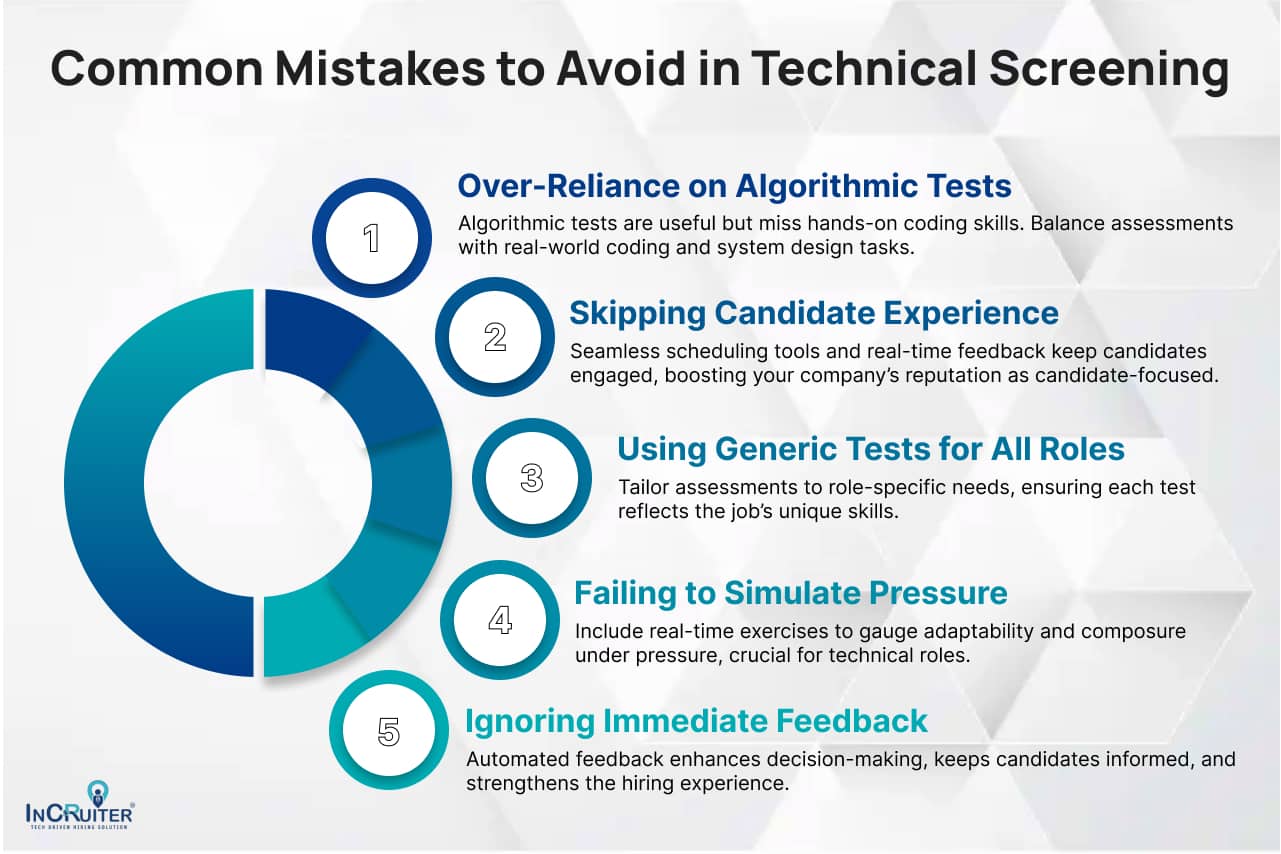
Avoiding pitfalls in technical screening is essential to identify candidates who can thrive in real-world environments. Here are some common mistakes to watch out for:
Over-Reliance on Algorithmic Tests
While algorithmic tests are helpful for assessing problem-solving skills, relying solely on them may overlook practical, hands-on coding abilities critical for day-to-day tasks. A balanced assessment should include challenges that simulate actual job demands—testing how well candidates can build, debug, and optimize code under realistic constraints.
System design questions, often facilitated through whiteboarding, add another layer by testing the candidate’s architectural thinking and ability to create scalable, efficient solutions.
Skipping the Candidate Experience
Creating a smooth, engaging process leaves a strong impression and minimizes drop-off rates. InCruiter’s Interview Scheduling Tool plays a key role here, enabling candidates to book interview slots effortlessly without unnecessary delays. This seamless scheduling reduces frustration and ensures candidates stay engaged.
Additionally, providing real-time feedback fosters a sense of appreciation, showing candidates that their effort matters. Even if they aren’t selected, this thoughtful approach gives them a positive perception of the hiring process, reinforcing your company’s reputation as a supportive, candidate-centric employer.
Using Generic Tests for All Roles
A one-size-fits-all approach doesn’t capture the unique requirements of each role. Tailored challenges that match the specific needs of different positions, from front-end development to back-end architecture, are critical.
Access to a diverse library of coding tasks and interview questions. Allows for assessments that genuinely reflect the role’s core requirements, ensuring that each test measures the skills that matter most for success.
Failing to Simulate Pressure Situations
In technical roles, candidates will often need to perform under pressure, facing tight deadlines or sudden challenges. Incorporating pair programming exercises can reveal how well they handle these situations, offering a view of their resilience and adaptability. This form of stress testing is essential for understanding a candidate’s problem-solving speed, composure, and ability to pivot quickly when necessary.
Ignoring Immediate Feedback
Timely feedback is crucial for both candidates and hiring teams, and this is where InCruiter’s automated reporting tools excel. With instant analytics, recruiters gain actionable insights into each candidate’s strengths and areas for improvement.
This approach enables faster, data-driven decision-making and keeps candidates informed, which significantly enhances their experience. By maintaining this feedback loop, InCruiter ensures that candidates feel valued and engaged. Creating a positive impression even for those who may not advance in the process.
Also read: Real-Time Collaboration: Why Pair Programming Interviews Matter
Conclusion
An efficient and thorough technical screening process is essential for building a team that’s both skilled and cohesive. By implementing advanced tools like InCruiter’s platforms, recruiters can streamline every stage—from precise job descriptions to real-time feedback. These tools not only enhance candidate experience but also ensure that only the best-fit candidates advance, making the process both effective and engaging.
Ready to elevate your hiring process? Explore the InCruiter demo or sign up for a trial to experience how these tools can transform your technical screening. Discover firsthand how InCruiter can help you attract, evaluate, and secure top talent with confidence and ease.






